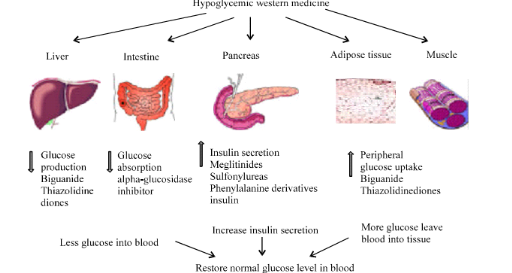I.1.9.2. Mechanism of
action of conventional oral hypoglycemic drugs
Oral hypoglycemia agents exert their glucose lowering effects
via a variety of mechanisms (Figure 6). These mechanisms of action include:
reduction of hepatic glucose production, (metformin, a biguanide), enhancement
of insulin secretion by pancreatic beta cells, (insulin secretagoges)
improvement of insulin sensitivity (metformin) and inhibition of intestinal
glucose digestion and absorption (alpha glucosidase inhibitors) (Baby
et al., 2011). The use of these drugs is however, limited by
the fact that they have adverse side effects, such as potential hypoglycemia
(e.g. sulfonylurea), weight gain, (meglitinides, sulfonylurea and
thiazolidinesdiones), gastro-intestinal discomforts (alpha glucosidase
inhibitors, and alpha amylase inhibitors) and lactoacidosis (TZDs and
metformin) (Cheng and Fantus, 2005). In addition to their
potential side effects, many of the oral anti-diabetic agents have higher
secondary failure rates.

Figure 7 :
Action site of western medicine in diabetes treatment (Baby et al.,
2011)
Oral agents may counteract insulin resistance, improve
ß-cell glucose sensing and insulin secretion, or control the rate of
intestinal glucose absorption. Combinations of oral agents, in particular
sulfonylureas plus metformin or thiazolidinediones plus metformin, have
improved the care of diabetic patients, and may be used when monotherapy is
ineffective (Craig et al., 2009).
I.1.9.2 Medicinal plants and herbs for diabetes
As it's the case with other diseases, medicinal plants have
been used since ancient times to treat and manage diabetes mellitus in
traditional medical systems of many cultures throughout the world
(Jung et al., 2006). Currently, medicinal plants
continue to play an important role in the management of diabetes mellitus,
especially in developing countries, where many people do not have access to
conventional antidiabetic therapies (Acharya and Shrivastava,
2008). In developed countries the use of antidiabetic herbal remedies
is reported to have been declining since the introduction of insulin and
synthetic oral hypoglycemic agents during the early part of the twentieth
century. However, in recent years, there has been a resurgence of interest in
medicinal plants with hypoglycemic potential in these countries (Paul
et al., 2006). This renewed interest in herbal antidiabetic
remedies in developed countries is believed to be motivated by several factors,
including, the side effects, high secondary failure rates and the cost of
conventional synthetic antidiabetic remedies (Paul et al.,
2006).
I.1.9.3. Bioactive ingredients (principles) of antidiabetic
medicinal plants
Ivorra et al (1989) studied the
structure of 78 different compounds isolated from plants with attributed
hypoglycemic activity. They classified these compounds according to the
following chemical groups:
i) polysaccharides and proteins (59 compounds)
ii) steroids and terpenoids (7 compounds)
iii) alkaloids (7 compounds)
iv) flavonoids and related compounds (5 compounds)
Similarly, Bailey and Day (1989) listed 29
compounds that contained 14 polysaccharides, 5 alkaloids, 4 glycosides and 6
other compounds. Grover, (2002) reviewed 45 medicinal plants
of India with confirmed antidiabetic potential. Of the 17 hypoglycemic
principles isolated and identified in this review 5 compounds are amino acids
and related compounds, 5 compounds are glycosides, and 3 compounds are phenolic
(flavonoids) compounds. The remaining compounds are alkaloids (2 compouds),
terpenoids (1 compound) and polysaccharides (1 compound). Bnouham
et al., (2006) also reviewed 178 medicinal plants with potential
antidiabetic activity.
| 


